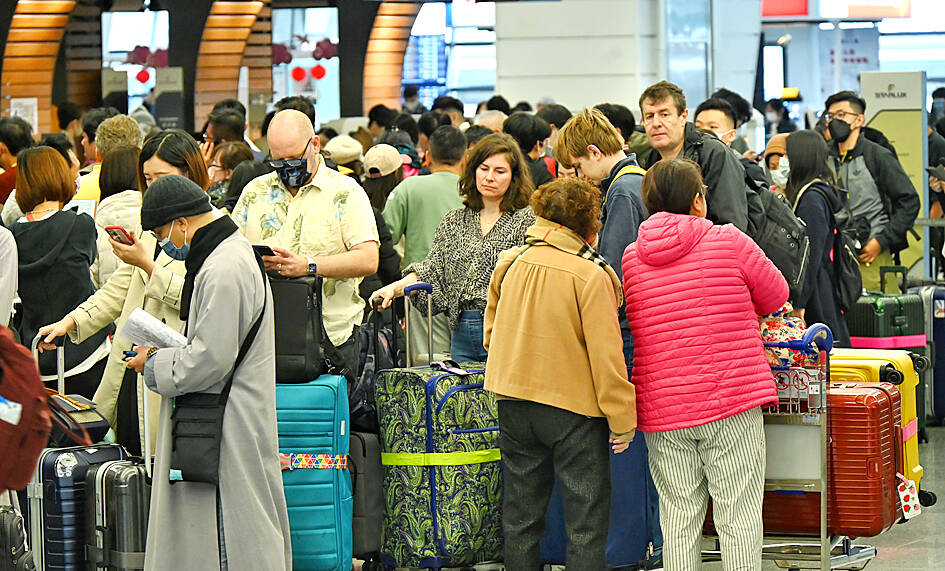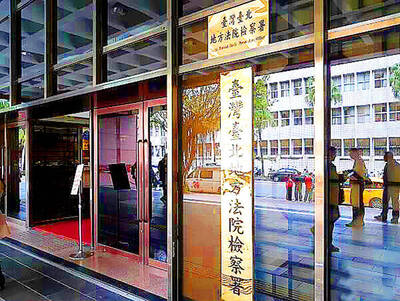The Tourism Administration yesterday canceled a plan to reopen group tours to China as Beijing had not reciprocated the show of goodwill from Taiwan and had instead unilaterally altered flight routes.
China might not be safe for Taiwanese to visit in light of the current situation and now is not the right time to resume two-way group tours across the Taiwan Strait, the agency said in a statement.
The agency’s original plan was to resume Taiwan-China group tourism, which had been suspended during the COVID-19 pandemic, on March 1.

Photo: Liu Hsin-de, Taipei Times
This plan is no longer appropriate, as Beijing has failed to reciprocate by allowing Chinese tour groups to visit Taiwan and showed hostility by making a slew of unilateral changes to flight routes near Taiwan, the agency said.
Chinese civil aviation authorities on Tuesday last week announced changes to rules governing civilian aircraft’s usage of flight paths M503, W121, W122 and W123.
Taipei has criticized the move as a breach of a bilateral agreement inked in 2015 and a danger to national security, as these changes to air traffic would reduce the depth of air defense for Taiwan proper.
The Mainland Affairs Council in August last year agreed to a plan by the Ministry of Transportation and Communications to unilaterally restore cross-strait tourism, which the government is still willing to entertain, the agency said.
“We continue to call on China to adjust its attitude toward Taiwan and allow Chinese tour groups to visit the nation as a show of goodwill,” the agency said, adding: “This will go a long way in repairing cross-strait exchanges in tourism.”
Starting today, tour agencies should stop organizing tours to China, it said.
However, Taiwanese who have already paid for group tours to China that are scheduled to depart between March 1 and May 31 would still be allowed to go to avoid legal conflict between consumers and tour agencies, the Tourism Administration said.
From June 1, groups tours would not be allowed, it added.
Minister of Transportation and Communications Wang Kwo-tsai (王國材) told a news conference that officials in an interministerial meeting jointly decided to reverse course on travel.
“We last year agreed to this as a gesture of goodwill,” but China has responded by poaching the nation’s allies and altering flight paths, he said.
“Pressing on with this policy without getting a friendly response is not something we can tolerate,” he added.
Members of the tourism and travel industry protested the abrupt policy U-turn.
The tourism industry had “waited long and hard for the business to come back only to see it suddenly halted again,” High Quality of Travel Association chairman Ringo Lee (李奇嶽) said in a video, adding that the policy change “shocked and saddened business owners.”
President-elect William Lai (賴清德) should explain the government’s policy after assuming office, he added.
The Tourism Administration did not consult or inform the industry before announcing the ban on China-bound tours, Travel Agent Association chairman Hsiao Po-jen (蕭博仁) said.
“The government’s word has no value,” he said.
Asked to comment, Phoenix Tours (鳳凰旅遊) general manager Benjamin Pien (卞傑民) said the sudden policy change would disrupt the industry as hotel reservations and services had already been sold and made, and would result in losses for the industry.
“Such restrictions should not exist in a free market,” he said.

INVESTIGATION: The case is the latest instance of a DPP figure being implicated in an espionage network accused of allegedly leaking information to Chinese intelligence Democratic Progressive Party (DPP) member Ho Jen-chieh (何仁傑) was detained and held incommunicado yesterday on suspicion of spying for China during his tenure as assistant to then-minister of foreign affairs Joseph Wu (吳釗燮). The Taipei District Prosecutors’ Office said Ho was implicated during its investigation into alleged spying activities by former Presidential Office consultant Wu Shang-yu (吳尚雨). Prosecutors said there is reason to believe Ho breached the National Security Act (國家安全法) by leaking classified Ministry of Foreign Affairs information to Chinese intelligence. Following interrogation, prosecutors petitioned the Taipei District Court to detain Ho, citing concerns over potential collusion or tampering of evidence. The

‘FORM OF PROTEST’: The German Institute Taipei said it was ‘shocked’ to see Nazi symbolism used in connection with political aims as it condemned the incident Sung Chien-liang (宋建樑), who led efforts to recall Democratic Progressive Party (DPP) Legislator Lee Kun-cheng (李坤城), was released on bail of NT$80,000 yesterday amid an outcry over a Nazi armband he wore to questioning the night before. Sung arrived at the New Taipei City District Prosecutors’ Office for questioning in a recall petition forgery case on Tuesday night wearing a red armband bearing a swastika, carrying a copy of Adolf Hitler’s Mein Kampf and giving a Nazi salute. Sung left the building at 1:15am without the armband and apparently covering the book with a coat. This is a serious international scandal and Chinese

Seventy percent of middle and elementary schools now conduct English classes entirely in English, the Ministry of Education said, as it encourages schools nationwide to adopt this practice Minister of Education (MOE) Cheng Ying-yao (鄭英耀) is scheduled to present a report on the government’s bilingual education policy to the Legislative Yuan’s Education and Culture Committee today. The report would outline strategies aimed at expanding access to education, reducing regional disparities and improving talent cultivation. Implementation of bilingual education policies has varied across local governments, occasionally drawing public criticism. For example, some schools have required teachers of non-English subjects to pass English proficiency

TRADE: The premier pledged safeguards on ‘Made in Taiwan’ labeling, anti-dumping measures and stricter export controls to strengthen its position in trade talks Products labeled “made in Taiwan” must be genuinely made in Taiwan, Premier Cho Jung-tai (卓榮泰) said yesterday, vowing to enforce strict safeguards against “origin laundering” and initiate anti-dumping investigations to prevent China dumping its products in Taiwan. Cho made the remarks in a discussion session with representatives from industries in Kaohsiung. In response to the US government’s recent announcement of “reciprocal” tariffs on its trading partners, President William Lai (賴清德) and Cho last week began a series of consultations with industry leaders nationwide to gather feedback and address concerns. Taiwanese and US officials held a videoconference on Friday evening to discuss the